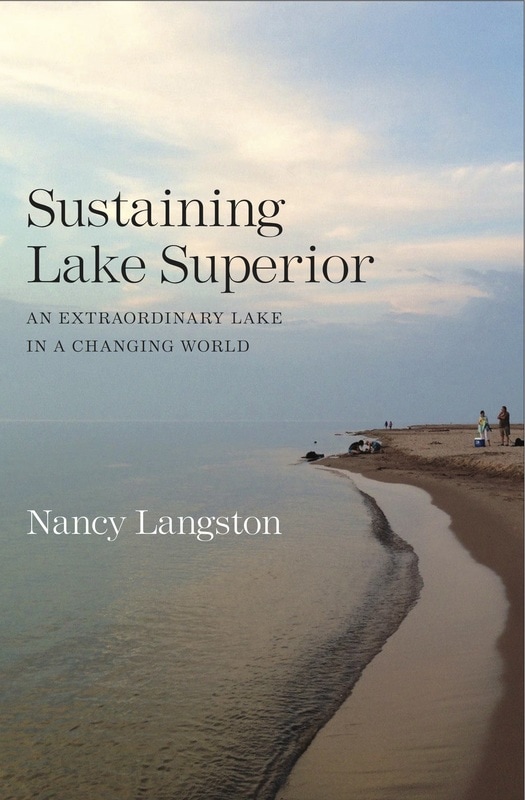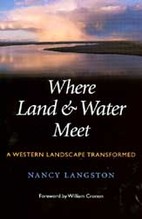Sustaining Lake Superior:
An Extraordinary Lake in a Changing World
|
How can communities help sustain the health of Lake Superior in the face of mining, climate change, forest change, invasive species, and emerging chemicals of concern? The challenges facing Lake Superior are many--yet local, regional, and international communities overcame enormous threats to the lake's ecosystems in the past century. Sustaining Lake Superior asks: What can we learn from the recoveries around Lake Superior over the past century, as we face new interconnected challenges from climate change, synthetic chemicals, and forest change? (Yale University Press 2017)
Praise for Sustaining Lake Superior“This insightful environmental history is a cautionary story about the true cost of the unenlightened commodification of Lake Superior. Like the Anishinaabe whose stewardship Nancy Langston chronicles, she invokes Seventh Generation thinking: make wise decisions today based on the best interests of future generations.”—Patty Loew, Bad River Anishinaabe
“A stirring biography of a most important place. Writing with insight and passion at the confluence of geography, ecology, and history, Nancy Langston connects the human story to that of the world’s largest lake, an enigma to many of us and an endangered species that affects all of us. Her voice is clear and honest, though never judgmental; it conveys welcome answers and hope for the future.”—Jack E. Davis, author of The Gulf: The Making of an American Sea "Nancy Langston has presented us with a masterful and vividly written study of the impact of industrial pollution, invasive species, and habitat loss on the world's largest freshwater lake. But it is her inquiry into the effects of climate change on Lake Superior that make this book the Silent Spring of freshwater ecology.”—Jerry Dennis, author of The Living Great Lakes and The Windward Shore: A Winter on the Great Lakes "Nancy Langston’s Sustaining Lake Superior is a wonderful book and an excellent addition to her existing body of work. Combining detailed historical and scientific evidence with penetrating insights into broader global issues, the book has much to offer not only to those interested in the environmental history of Lake Superior but also to anyone concerned with the fate of the planet.”—Tim LeCain, author of Mass Destruction: The Men and Giant Mines That Wired America and Scarred the Planet “A Great Lake deserves a great book, and Nancy Langston has written it. Carefully researched, scientifically literate, appropriately transnational, handsomely illustrated, and engagingly written, this book is a shining example of environmental history at its best.”—J.R. McNeill, co-author of The Great Acceleration: An Environmental History of the Anthropocene since 1945 |
“With passion and grace, Nancy Langston explores why environmental policies have achieved such mixed results. Lake Superior reveals how environmental ideas sufficient for one era too often fail in another.”—Richard White, Stanford University author of Railroaded: The Transcontinentals and the Making of Modern America and The Organic Machine: The Remaking of the Columbia River “In Sustaining Lake Superior, Nancy Langston takes stock of the big lake and the surrounding region. She dives into to the geology, biology, and human dimensions and shows how they are all intertwined. This fascinating book makes it clear why Lake Superior deserves our respect and protection: we are part of the lake, and the lake is part of us.”—William Rapai, author of Lake Invaders: Invasive Species and the Battle For the Future of the Great Lakes “The deep originality of this work consists not just in its oddly specific subject, Lake Superior, but also in its general and iterative argument about there being several very different kinds and scales of causality at work, both in environmental degradation and in restoration.”—Colin Duncan, author of The Centrality of Agriculture: Between Humankind and the Rest of Nature “Langston has written nothing less than the definitive biography of the Greatest Lake, from its birth right up to its current encounter with climate change. It is a wonderful, moving story, and as she eloquently describes, a new and challenging chapter must now be written.”—James Gustave Speth, former Dean, Yale School of Forestry and Environmental Studies and author of America the Possible: Manifesto for a New Economy |
Toxic Bodies: Hormone Disruptors and the Legacy of DES
|
Toxic Bodies: Hormone Disruptors and the Legacy of DES was published in 2010 by Yale University Press. To learn more, please visit the website for Toxic Bodies.
Praise for Toxic Bodies “Nancy Langston has given us a deeply disturbing analysis of government neglect of synthetic hormones. By taking us back to the beginning of the twentieth century, she traces the failure of the U.S. Food and Drug Administration to protect society from hormonally active drugs, growth stimulants fed to livestock, and chemical ingredients in plastics. This is a wonderful history, woven together by deep insight into both public health and ecology, one with many lessons for modern precautionary policy.You owe it to your children and future generations to pay attention to this book. And we all owe Langston a debt of gratitude for illuminating a global hormonal chemical experiment that is wildly out of control.” --John Wargo, Professor of Risk Analysis and Political Science, Yale University
|
| ||||||||||||||
Where Land and Water Meet: A Western Landscape Transformed
|
Where Land and Water Meet: A Western Landscape Transformed (University of Washington Press, 2003) focuses on dilemmas over riparian management in the West. This study examines the ways different cultures have transformed riparian systems and the ways scientific and cultural ideas of nature have affected those transformations.
|
Forest Dreams, Forest Nightmares:
The Paradox of Old Growth in the Inland West
|
Forest Dreams, Forest Nightmares (University of Washington Press, 1995) examines the causes of the forest health crisis on western national forests. Forest Dreams won the 1997 Forest History Society book prize for best book in forest and conservation history published in the preceding two years.
|
|
Steen-Adams, M. M, N. Langston, and D. J Mladenoff. 2007. “White Pine in the Northern Forests: An Ecological and Management History of White Pine on the Bad River Reservation of Wisconsin.” Environmental History 12 (3): 614–648.
|
| ||||||||||||
|
Langston, N. 2005. “Reflections on Teaching World Forest History.” Environmental History 10: 20-29.
Langston, N. 2000. "When Sound Science is Not Enough: Regulating the Blues." Journal of Forestry 98: 31-35.
Langston, N. 1999. "Environmental and Human Change in Old Growth Forests," Research in Social Problems and Public Policy 7: 253-271.
Langston, N. 1998. Environmental History and Restoration in the Western Forests. Journal of the West 38: 45-56. |
| ||||||||||||||||||||||||
PEER-REVIEWED ARTICLES: ecology & evolution
|
Langston, N., S. Rohwer, and D. Gori. 1997. Experimental Analysis Of Intra And Intersexual Competition In Red-Winged Blackbirds. Behavioral Ecology 8: 524-533.
Rohwer, S., N. Langston, and D. Gori. 1996. Body Size In Male Redwinged Blackbirds: Manipulating Selection With Sex-Specific Feeders. Evolution 50: 2049-2065.
Langston, N. and S. Rohwer. 1996. Molt/breeding Tradeoffs In Albatrosses: Implications For Understanding Life History Variables. Oikos 76: 498-510.
Langston, N. and S. Rohwer. 1995. Unusual Patterns of Incomplete Primary Molt in Laysan and Black-footed Albatrosses. Condor 97: 1-19.
Langston, N. and N. Hillgarth. 1995. The Extent Of Primary Molt Varies With Parasites In Laysan Albatrosses: A Possible Role In Life History Tradeoffs Between Current And Future Reproduction. Proceedings of the Royal Society of London (series B) 261: 239-243.
Langston, N., S. Freeman, D. Gori, and S. Rohwer. 1990. Evolution of Body Size in Female Redwinged Blackbirds: Effects of Female Competition and Reproductive Energetics. Evolution 44: 1764-1779.
|
| ||||||||||||||||||||||||||||||||||||
SELECTED BOOK CHAPTERS
|
Langston, N. 2012. “Global forest change.” Chapter in J.R. McNeill and Erin Stewart Mauldin, eds., A Companion to Global Environmental History. Oxford University Press.
Langston, N. 2010. "Air: Climate Change and Environmental History." Pp 33-50 in A Companion to Environmental History, ed. Doug Sackman, Blackwell Companions to American History (New York: Wiley). Langston, N. 2006. “Restoration in the American National Forests: Ecological Processes and Cultural Landscapes.” Chapter in The Conservation of Cultural Landscapes, ed. Mauro Agnoletti. CABI Press. 173-183.
|
| ||||||||||||||||||
|
Langston, N. 2005. "Resource Management as a Democratic Process: Adaptive Management on Federal Lands." Chapter in Communities and Forests: Where People Meet the Land. ed. Don Field and Robert Lee, Oregon State University Press. 52-76.
Langston, N. 2005. "Floods and Landscapes in the Inland West" Chapter in City, Country, Empire: Landscapes in Environmental History, ed. Jeffrey Diefendorf and Kurk Dorsey. U. of Pittsburgh Press. 99-121.
|
| ||||||||||||
|
Langston, N. 2003. "Gender Transformed: Endocrine Disruptors in the Environment." Chapter in Seeing Nature through Gender, ed. Virginia Scharff. U. of Kansas Press. 129-166.
Nancy Langston, 1998. "People and nature: understanding the changing interactions between people and ecological systems" pp. 25-76 in S. Dodson, T. Allen, S. Carpenter, A. Ives, R. Jeanne, J. Kitchell, N. Langston, and M. Turner. Ecology. Oxford University Press.
Langston, N. 1997. "Forest Dreams, Forest Nightmares: An Environmental History of a Forest Health Crisis." Chapter in American Forests: Nature, Culture, and Politics. Ed. Char Miller. U. Press of Kansas. 247-271.
|
| ||||||||||||



